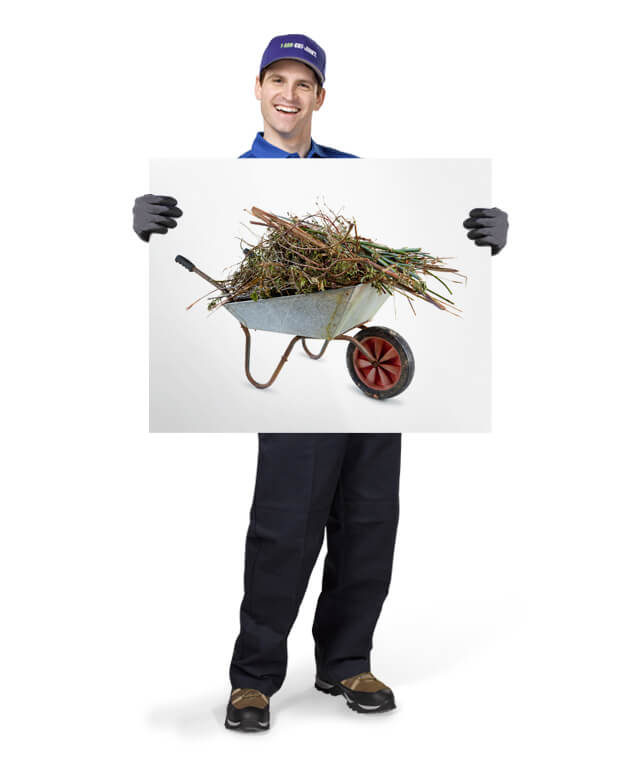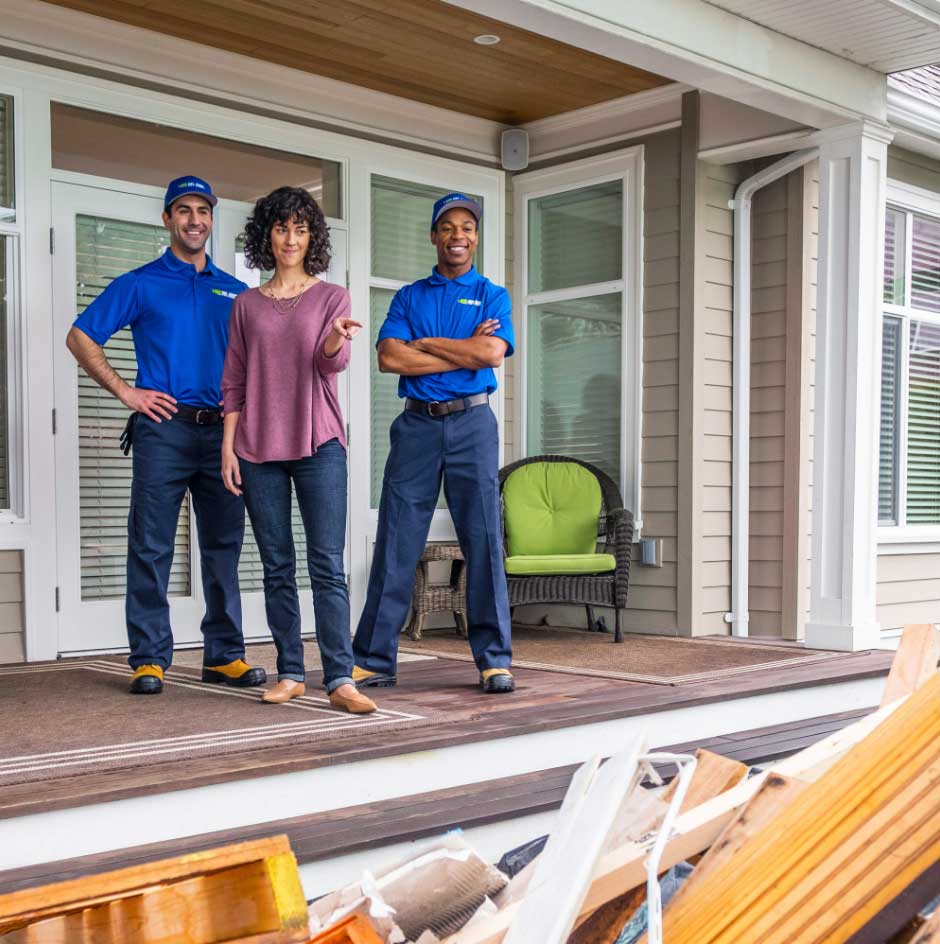Fast, friendly yard waste removal service
Whether it’s piles of leaves, weeds from the garden or just about anything in between, yard waste removal can be a pain—especially if you don’t have any helping hands.
The growing number of laws banning yard waste from landfills have caused many local garbage collectors to not accept bags filled with leaves, grass clippings, and tree debris.
Keeping yard waste on your property can dampen your curb appeal. Luckily, you have options when you’re ready to get rid of your green waste—like calling the friendly experts in your neighborhood over at 1-800-GOT-JUNK?
Types of yard waste we dispose of
As long as no hazardous materials are present, 1-800-GOT-JUNK? can take leaves, branches, trimmings and any other yard waste you have for us, including:
- Leaves
- Grass Clippings
- Twigs
- Mulch
- Yard Debris
- Shrubs
- Tree Trunks
- Holiday Trees
- Biological Waste
- Hedge Trimmings
- Weeds & Plants
Why should you hire 1-800-GOT-JUNK? for yard waste and tree debris pick up services?
When you call the expert crew at your local 1-800-GOT-JUNK?, they’ll take all the stress and worry out of any junk removal you need taken care of—including yard waste. Our team will take care of this one so you can take back some of your limited free time! We’re in your neighborhood—find a 1-800-GOT-JUNK? location near you now.
How our pricing works
The final cost of your junk removal can vary greatly depending on what we take, how much needs to be removed and how big of a crew will be needed to get the job done. 1-800-GOT-JUNK? is always happy to provide you with a free onsite, zero-obligation estimate, so don’t hesitate to contact us if you have any questions. Click here to see our pricing.
Tree Debris Removal
Tree debris can come from storms, landscaping activities, or construction and can be quite messy to get rid of. 1-800-GOT-JUNK? offers tree debris removal services for your home or office. We’ll take anything non-hazardous that two strong truck team members can lift into our trucks. We don’t do landscaping work, but when you have piles of yard waste sitting around, we can get rid of it for you and even clean up the area once we’re done!
Yard waste removal FAQs
Yard waste, also known as “green waste” or “biological waste,” is any vegetative or organic waste leftover from lawn and garden landscaping. Dry leaves, grass clippings, stalks, branches, twigs, mulch, garden waste, tree trunks, holiday trees, general yard debris, and prunings from trees or shrubs are all considered yard waste.
Are you wondering what to do with your yard waste? Here are some options available to dispose of yard waste in an efficient manner:
- Rent a Roll-Off Dumpster from your local waste management company to get rid of yard waste and debris, if you don’t mind loading the dumpster yourself.
- Contact your local trash collection service to check if they can arrange a yard debris pickup to dispose of your yard waste.
- Hire a junk removal company such a 1-800-GOT-JUNK? to handle all the work and dispose of your yard waste in an eco friendly manner whenever possible.
- Mulch mow your yard waste and leave it on the lawn.
- If they can fit into garbage bags, then collect the debris and take the bags to a leaf drop-off site to get rid of the yard waste.
- Check if your neighborhood participates in curbside composting for yard waste disposal. If not, then you can also compost the waste at home.
Fallen/downed tree disposal
When a tree falls over or is downed, the first step to proper disposal is removing the branches by snapping them or cutting them off. This will give you easier access to the trunk of the tree.
Once the branches and leaves are removed and clear of the limb, someone will have to chop up the trunk into manageable pieces. This is easiest to complete with a saw and can be physically intensive depending on the size of the tree. If this sounds like too much to do on your own, it probably is! Calling a local tree removal or landscaping service might be your best option.
Once you have the branches separated and the trunk cut into manageable logs, the next step is getting rid of it all. If you have a fireplace, oak, birch, or maple wood is perfect firewood. If you don’t have a fireplace, you’ll have to get the remaining wood to the correct waste facility.
1-800-GOT-JUNK? can help you with this! We’re a full-service junk removal company and our friendly truck teams can haul all the branches and logs to your local green waste facility so that you can spend your time and energy on more important things.
Stump removal
Getting rid of a tree stump on your property is time-intensive and laborious work. For most people, it’s recommended that you hire a landscaper or a specialized tree removal company given the nature of the work required.
The stump of a tree is designed by nature to be hard to dig out. The root system was made to hold up a tall tree that can weigh hundreds or thousands of pounds. This means that special products are required to get rid of a tree stump.
The quickest way to get rid of a tree stump is to hire a local tree removal service with specialized stump grinders. It’s noisy business, but stump grinders are specially designed to turn your tree stump into wood chips quickly.
Some local landscaping services may offer tree stump removal by using chemicals to cause the stump to deteriorate to a point where it’s easier to chop it up or dig it out. This process requires the drilling of multiple holes into the stump, adding special chemicals to the holes, and allowing the stump time to absorb them and deteriorate. At the end of the process, you still need to dig and chop up the stump, but it’ll be a more reasonable amount of effort to do so.
Once the stump is out of the ground and in manageable piles of wood or chopped into wood chips, you’ll need to transport those to a green waste facility in your town. If your personal vehicle doesn’t have enough space to do this, or you don’t want to get it covered in dirt and wood splinters, call a full-service junk removal company like 1-800-GOT-JUNK? to come and dispose of your tree stump for you. We can carry away your broken down wood and haul it to the right disposal center for you.
Here’s why you should not put yard waste in trash or recycle bins:
- Some cities in the US have banned it and it’s illegal to dump yard waste and debris with household trash or in kitchen recycling bins.
- Organic waste in the recycle bins and green materials can be processed and turned into mulch. However yard waste such as soil, rocks, treated woods, broken pots, etc. cannot be recycled.
- It becomes difficult for the local trash and waste management companies to segregate and dispose of yard waste and debris if they are mixed with household trash.
- Keeping yard waste out of recycle bins and garbage is a small step towards a greener environment.
A popular way to handle leftover tree branches is to run them through a wood chipper. Once the branches are broken down, the wood chips can be spread around gardens and plants as a homemade, moisturizing mulch. Some cities operate communal wood chippers to keep the community free of green waste. Find out if your city has a yard-waste donation program or if your local waste collectors offer branch collection.
After you're done mowing your lawn, there are several ways to clean up the grass clippings. One way is to rake the trimmings up, place them in biodegradable yard waste bags, and set them on your curb for pickup. Another option is to leave the cut grass on your lawn. This “grasscycling” process allows the old grass to break down and add nutrients back into the soil. Grass clippings can also be added to a compost heap or used as a moisture-providing mulch.
If you have yard trimmings piled up on your property, the most eco-friendly option is to recycle them. Here are 5 ways you can recycle your yard trimmings:
- Use green waste in compost piles.
- Use trimmings as moisturizing mulch.
- Leave trimmed grass on your lawn too grass cycle the cut grass.
- Schedule a pickup from your local recycling companies.
- Hire a junk hauler to take your yard waste to a recycling facility.
Don’t let your trimmings go to waste—recycling is good for your curb appeal and the planet.
Once you’re done working in your yard, your next step is to clean up the leftovers. The easiest way to get rid of your tree branches, bush trimmings, and lawn clippings is schedule a waste pickup.
Here’s how you can prepare for your lawn waste pickup:
- Before you start, purchase large, biodegradable bags to collect the trimmings.
- Gather the waste with gloved hands, shovels, or rakes.
- Place the waste into the bags.
- Tie the bags up securely.
- Place the bags on the curb for their scheduled pickup.
Remember, not all waste management services collect green waste. If this is the case in your community, feel free to call our clean and professional crew to do it for you—hassle free!
Although you may find them in your yard, bagged dirt, bagged soil, rocks, panters, treated or coated wood, large trees or stumps, and concrete are not considered yard waste and may not be accepted with the rest of your yard waste pickup. Of course, every collection service is different. Check with your city’s waste management service or local private collection companies to find out what sort of yard waste they accept.
Also known as “fly dumping” or “fly tipping,” dumping garden debris or any other green waste anywhere but an authorized waste collection area is illegal. Instead of dumping your garden waste into areas it does not belong, there are several alternative methods that are both legal and safe for the environment.
These methods include:
- Composting
- Recycling
- Using waste as mulch
- Renting a dumpster
- Scheduling a pickup from a local junk hauler or waste collection company

